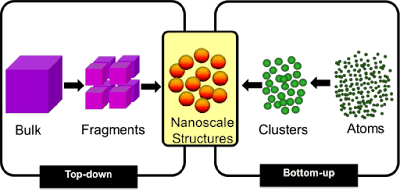Nanoscience
Nanoscience is the study of structures and materials on the scale of nanometers. Nano means one-billionth of a meter that is 10-9 m. If the matter is divided into such small objects the mechanical, electrical, optical, magnetic and other properties change.
Nanotechnology
Nanotechnology is a technology involving the design, production, characterization, and applications of nanostructured materials.
Nanoparticles
The solids are made up of particles. Each of the particles has a definite number of atoms, which might differ from material to material. If the particle of a solid is of size is less than 100 nm, it is said to be 'nano solid'. When the particle size exceeds 100 nm, it is a 'bulk solid'. It is to be noted that nano and bulk solids may be of the same chemical composition.
Nano in Nature
No. 1
The scales on the wings of a morpho butterfly contain nanostructures that change the way light waves interact with each other, giving the wings brilliant metallic blue and green hues.
No. 2
Peacock feathers get their iridescent colouration from light interacting with 2-dimensional photonic crystal structures just tens of nanometers thick.
No. 3
Parrotfish crunches up coral all day. The source of the parrotfish's powerful bite is the interwoven fibre nanostructure. Crystals of a mineral called fluorapatite are woven together in a chain mail-like arrangement. This structure gives parrotfish teeth incredible durability.
Synthesis of Nanoparticles
The nanostructures made in the laboratory mimic some of nature's amazing nanostructures. As the nanostructures are so small, specialized methods are needed to manufacture objects in this size range. There are two ways of preparing the nanomaterials, top-down and bottom-up approaches.
Top-Down approach
Nanomaterials are synthesized by breaking down bulk solids into nano sizes. Examples include Ball milling, sol-gel, lithography.
Bottom-Up approach
Harmful Effects of Nanoparticles
The research on the harmful impact of the application of nanotechnology is also equally important and fast developing. The major concern here is that the nanoparticles have dimensions the same as that of biological molecules such as proteins. They may easily get absorbed onto the surface of living organisms and they might enter the tissues and fluids of the body.
Adsorbing nature depends on the surface of the nanoparticle. Indeed, it is possible to deliver a drug directly to a specific cell in the body by designing the surface of a nanoparticle so that it adsorbs specifically onto the surface of the target cell.
The interaction with living systems is also affected by the dimensions of the nanoparticles. For instance, nanoparticles of a few nanometers size may reach well inside biomolecules, which is not possible for larger nanoparticles. Nanoparticles can also cross cell membranes. It is also possible for the inhaled nanoparticles to reach the blood, to reach other sites such as the liver, heart or blood cells.
Researchers are trying to understand the response of living organisms to the presence of nanoparticles of varying size, shape, chemical composition and surface characteristics.
Conclusion
Did I miss any info about Nanoparticles? If you have some new information you’d like to share, let me know in the comments.





Post a Comment
Leave us a comment